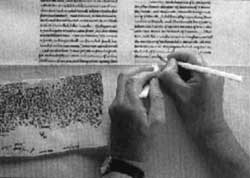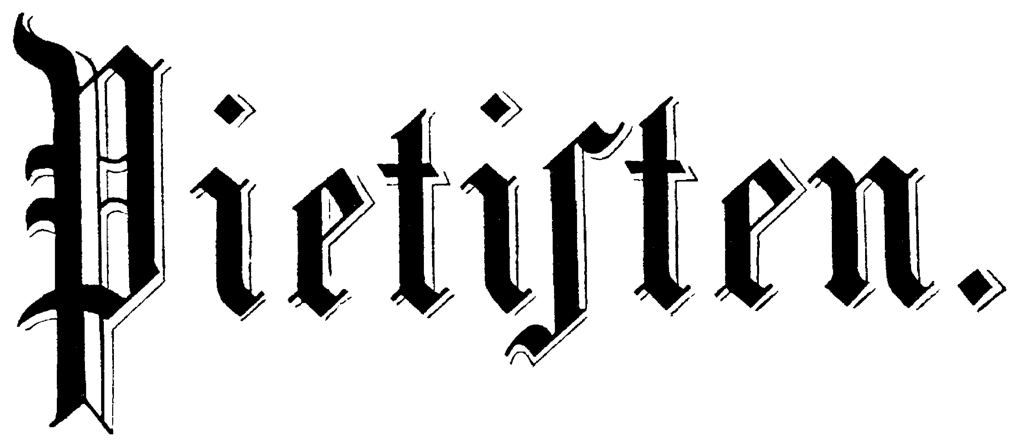Big Bible News
Glancing into any office in the building where I work, it appears that everyone, at every desk, is peering at a glowing screen. Even the UPS man who comes in delivering a book from Barnes and Noble has a portable screen to check every few minutes. Now, if any of these people are secretly yearning for the thickness and tactility of handsome, elegant letters on beautiful paper, and are tired of type that merely floats on the surface, help is definitely on the way.
St. John's University in Collegeville, Minnesota (the birth place of Minnesota Public Radio) is slowly and very surely producing the first Bible to be written and illustrated entirely by hand since the invention of moveable type more than 500 years ago. This St. John's Bible, a ten-year project, is now half-way complete. Donald Jackson, a world famous calligrapher and the official scribe to Queen Elizabeth, is in charge of this brilliant and unusual project. The Bible he is preparing will be in seven volumes, containing 160 hand-painted illuminations, comprising 1,150 pages. It will be two feet tall and three feet wide when opened.

The illustrations or illuminations will reflect current times, including the flora, fauna, small animals, and birds found, for example, in Minnesota. The actual writing and the illuminations are being done exactly as medieval monks worked a thousand years ago. Jackson and his team of scribes are busy in Wales, near Tintern Abbey, copying out each page on vellum which is calf skin that has been steeped in lime and then scraped and sanded. This surface grabs and holds the ink in a manner highly valued by master calligraphers. Jackson, who designed a new type script just for this project, claims that calligraphy is a performance, like dancing or ice skating.
The paintings or illuminations are in tempera. Jackson grinds lapis lazuli for brilliant blues, vermilion for red, and malachite for greens. The yolk of an egg is added to some of the colors to add luster and depth. Fish glue, sugar, and powdered white lead combine for gesso. After Jackson applies the gesso, he breathes on it gently through a slender reed as it dries. This provides the moisture that will allow gold leaf to adhere so it can be burnished to a dazzling and lasting brilliance. Hello high art, good-bye laser printer.
When the St. John's Bible is finished it will be exhibited first at the Minneapolis Institute of Arts and then tour museums around the country. New York City, Detroit, Chicago, Los Angeles and Seattle are a few of the selected sites. An excited Evan Maurer, the Director of the Minneapolis Institute of Arts recently said, "What better thing can you work on than Holy Scriptures?" After the museum tour, the St. John's Bible will be kept, and used, in Collegeville, Minnesota.
There will be just one St. John's Bible, but a small fine letter press company, situated in the Presidio in San Francisco, is currently making four hundred extraordinary Bibles in the tradition of Gutenberg and other great printers who used the technique of pressing high quality paper one sheet at a time onto moveable lead type covered with ink which is then embedded deep into the page. This technique is now extremely rare but the Arion Press (named for the poet in Greek mythology who wooed a dolphin to carry him from imminent death on the high seas) is deeply dedicated to this art. It is time-consuming, but the result can be breathtaking. The 50-pound Arion Bible, set in 16 point Romulus type, is 18 inches by 26 inches open with 1,232 pages.
I first learned of the Arion Bible when I saw its designer and creator, Andrew Hoyem, on the NewsHour with Jim Lehrer earlier this year. Hoyem displayed samples of his beautiful pages, described the printing process he has mastered, and then quietly noted that this would probably be the last Bible ever made from moveable type. The next-to-the-last beautiful letterpress Bible was the celebrated Oxford lectern Bible designed by Bruce Rodgers and published in 1935. "This Oxford Bible," Hoyem said, "is truly a beautiful book. Many feel it is the most beautiful book of the 20th century." This line begins in 1455 with Gutenberg in Mainz, Germany, with some extremely significant and handsome steps along the way, and continues down to 2000 and Arion in San Francisco. And that's it.
Printing the Arion Bible suggests hard work, like building a cathedral. Heavy galleys of lead type need to be hefted about and clamped together. And the press is physically pulled down onto the all-cotton fiber paper—one strike for each page. This classic technique, taught to many in schools in this country for hundreds of years (including to me in the seventh grade), is now nearly extinct.
I recently spoke to several of the employees in the Arion Press about their Bible. They are extremely proud of this achievement. Orders for most of the edition of 400 have been placed. Three are bound for Minnesota, including Luther Sem-inary, the University of Minnesota Special Collections Department, and, wouldn't you guess it? St John's University. Arrangements, it can here be reported, are also underway to have a copy donated to North Park University in Chicago.
Whereas the St. John's Bible will cost over four million dollars, the Arion Bibles are priced at $8,000. Both the St. John's and Arion Bibles used Macintosh computers to help lay out the pages, which seems to be a fine use of high technology. And both Bibles use the New Revised Standard Version translation (1989), which is a revision of the Revised Standard Version published in 1952, which was a revision of the American Standard Version, published in 1901, which had embodied earlier versions of the King James Version, sometimes called the Authorized Version, published in 1611.
Some fans of the King James Version, myself included, may wonder why it wasn't used. The decision seems to have been made, in both cases, based on the NRSV's more recent scholarship, inclusive language, and very wide acceptance and use. Bruce Metzger, chairman of the committee of translators, in his preface to the NRSV writes:
In traditional Judaism and Christianity, the Bible has been more than a historical document to be preserved or a classic of literature to be cherished and admired; it is recognized as the unique record of God's dealing with people over the ages. The Old Testament sets forth the call of a special people to enter into covenant relation with the God of justice and steadfast love and to bring God's law to the nations. The New Testament records the life and work of Jesus Christ, the one in whom "the Word became flesh," as well as describes the rise and spread of the early Christian Church. The Bible carries its full message, not to those who regard it simply as a noble literary heritage of the past, or who wish to use it to enhance political purposes and advance otherwise desirable goals, but to all persons and communities who read it so that they may discern and understand what God is saying to them. That message must not be disguised in phrases that are no longer clear, or hidden under words that have changed or lost their meaning: must be presented in language that is direct and plain and meaningful to people today. It is the hope and prayer of the translators that this version of the Bible may continue to hold a large place in congregational life and to speak to all readers, young and old alike, helping them to understand and believe and respond to its message.
Somehow as I read and thought about these two Bibles, and even about the translator's statement, of which the above is just a small excerpt, my old objections to a modern translation and even to "inclusive" language began to evaporate. And my own feeling for the Bible began to increase. I am aware of a new, deeper appreciation of this magnificent book so lovingly and artfully being produced in Minnesota, Wales, and California.
